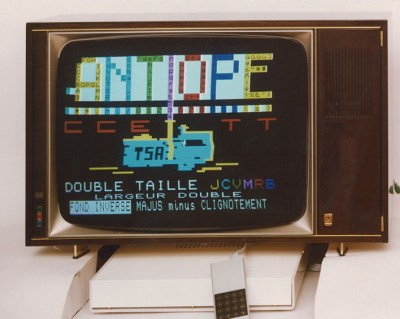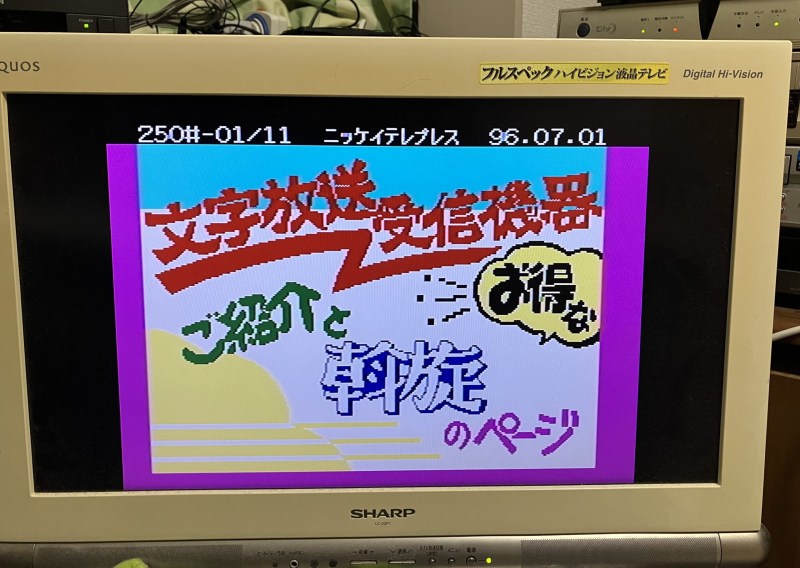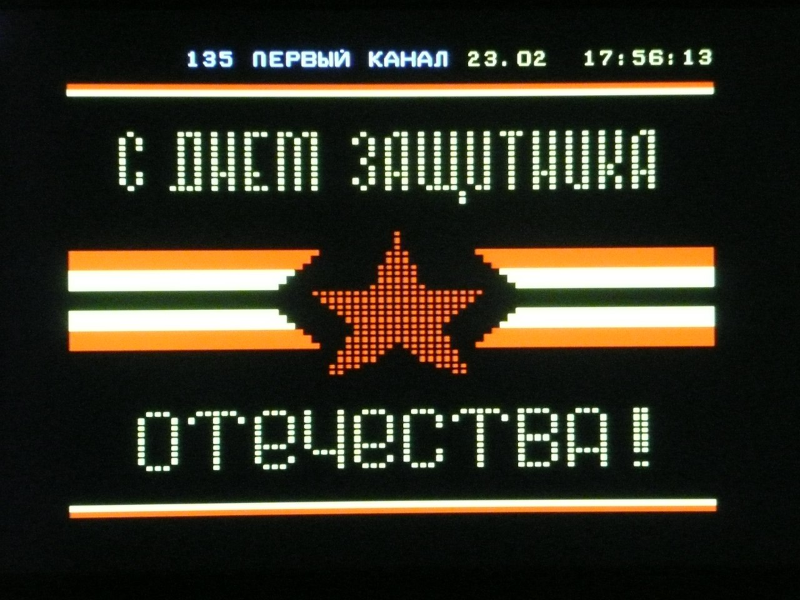When you mention Teletext or Videotex, you probably think of the 1970s British system, the well-known system in France, or the short-lived US attempt to launch the service. Before the Internet, there were all kinds of crazy ways to deliver customized information into people’s homes. Old-fashioned? Turns out Teletext is alive and well in many parts of the world, and [text-mode] has the story of both the past and the present with a global perspective.
The whole thing grew out of the desire to send closed caption text. In 1971, Philips developed a way to do that by using the vertical blanking interval that isn’t visible on a TV. Of course, there needed to be a standard, and since standards are such a good thing, the UK developed three different ones.
 The TVs of the time weren’t exactly the high-resolution devices we think of these days, so the 1976 level one allowed for regular (but Latin) characters and an alternate set of blocky graphics you could show on an expansive 40×24 palette in glorious color as long as you think seven colors is glorious. Level 1.5 added characters the rest of the world might want, and this so-called “World System Teletext” is still the basis of many systems today. It was better, but still couldn’t handle the 134 characters in Vietnamese.
The TVs of the time weren’t exactly the high-resolution devices we think of these days, so the 1976 level one allowed for regular (but Latin) characters and an alternate set of blocky graphics you could show on an expansive 40×24 palette in glorious color as long as you think seven colors is glorious. Level 1.5 added characters the rest of the world might want, and this so-called “World System Teletext” is still the basis of many systems today. It was better, but still couldn’t handle the 134 characters in Vietnamese.
Meanwhile, the French also wanted in on the action and developed Antiope, which had more capabilities. The United States would, at least partially, adopt this standard as well. In fact, the US fragmented between both systems along with a third system out of Canada until they converged on AT&T’s PLP system, renamed as North American Presentation Layer Syntax or NAPLPS. The post makes the case that NAPLPS was built on both the Canadian and French systems.
That was in 1986, and the Internet was getting ready to turn all of these developments, like $200 million Canadian system, into a roaring dumpster fire. The French even abandoned their homegrown system in favor of the World System Teletext. The post says as of 2024, at least 15 countries still maintain teletext.
So that was the West. What about behind the Iron Curtain, the Middle East, and in Asia? Well, that’s the last part of the post, and you should definitely check it out.

If you are interested in the underlying technology, teletext data lives in the vertical blanking interval between frames on an analog TV system. Data had page numbers. If you requested a page, the system would either retrieve it from a buffer or wait for it to appear in the video signal. Some systems send a page at a time, while others send bits of a page on each field. In theory, the three-digit page number can range from 100 to 0x8FF, although in practice, too many pages slow down the system, and normal users can’t key in hex numbers.
For PAL, for example, the data resides in even lines between 6 and 22, or in lines 318 to 335 for odd lines. Systems can elect to use fewer lines. A black signal is a zero, while a 66% white signal is a one, and the data is in NRZ line coding. There is a framing code to identify where the data starts. Other systems have slight variations, but the overall bit rate is around 5 to 6 Mbit/s. Character speeds are slightly slower due to error correction and other overhead.
Honestly, we thought this was all ancient history. You have to wonder which country will be the last one standing as the number of Teletext systems continues to dwindle. Of course, we still have closed captions, but with digital television, it really isn’t the same thing. Can Teletext run Doom? Apparently, yes, if you stretch your definition of success a bit.
















It’s important not to confuse teletext delivery in analogue composite VBI with the continued running of teletext services.
Many European countries have continued to use the same 40×25 WST system long after analogue TV was switched off by saying the same WST system but with the data delivered as a PID in an MPEG2 transport stream in DVB-T/T2/S/S2/C DVB digital TV streams. This continues in Germany and Sweden for example – and in many other countries (including the UK) just for subtitle (aka closed caption) delivery on some platforms (Sky uses WST subtitles in the UK for example)
The Dutch teletext system can be accessed via ssh at teletekst.nl!
Ha!, didn’t know that, I knew it had tekst, json, and html versions over https, but I did not know about ssh.
I often use the app and site for good, very concise, versions of the most important news of the moment.
Or read Teletekst in your console: https://github.com/zevv/termtekst
The only problem is, it’s like trying to read while heavily intoxicated.
I recall visiting my father back in 2001 and calling up Ceefax page 150 only see a newsflash saying a plane had crashed into a building in New York.
Anyone who has never used Teletext can see a live emulator here: https://nmsceefax.co.uk
Any fans of Bamboozle or Digitised here?
Bamboozle was the highlight of my Sunday afternoon!
I like to mention that the emulation is specifically of a teletext decoder, the pages aren’t just being put together in the browser with a rolling clock for effect – everything you see is ultimately coming from a live teletext packet stream of Nathan’s re-created Ceefax service.
If you call up the newsreel on page 152 you can watch the same signal rendered in glorious SD analogue by vintage decoder chips on YouTube (albeit with an annoyingly long re-encoding delay which diminishes the effect slightly) at https://www.youtube.com/watch?v=v8OUAiWH_jc
Sadly you can’t use use “mix mode” to put one on top of the other for a freaky 3D effect 😆
I’ve used that for years now as a simple news reader!
Bamboozle was interesting because it exploited the fact that page numbers are actually in hex (or at least the last two digits are). You almost never saw this being used as normal remotes don’t have a way to enter A-F, but it was useful for quizzes because they could put the answers on pages which were not directly accessible; you had to get to them using the Fastext links at the bottom of the page (using the colour buttons on the remote).
Or you could use your Teletext adapter board on your computer and just directly download all the answer pages. whistles innocently
Great read! I really enjoy the nostalgic look of teletext, and it’s amazing that it’s still used for news in many countries, as well as for fun, quirky things like playing doom in teletext.
One thing I’m curious about—do the header image and the Japanese teletext image actually show teletext 1.5 pages? The colors don’t seem to match the standard 8 default colors (black, white, red, green, blue, cyan, yellow, magenta).
Could it be that different countries use different default color sets?
After reviewing the linked page in detail, I found that the Japanese page refers to ‘JTES,’ not ‘World System Teletext’ as it’s known in the UK. That describes the different look.
I’m still unsure about the Russian page, but there’s a podcast linked on the page that might provide more detailed information.
MiniTel, had in Ireland too – French version. Fun. Friend made $$$ right out of college writing a hangman game…
ok I have sdr v 4 (RTL) how starting read the teletext?
It’s still in use in Denmark too and I actually use it now and then. Although by now over the Internet since we don’t have any antenna – everything we watch is streamed.
When I was a kid in the 70s, DR (Danish Broadcasting Corporation) started experimenting with teletext. It wasn’t always active but you could tell by looking at the test card which was very prevalent then. In the middle of the test card the letters DR was always shown. If there was an additional trailing dot (DR.) you knew there was something to read on teletext.
To this day, Videotext and Videotex (no t) are being mixed up.
First one is also being called Teletext and an over the air medium.
Second one is a family of a landline based online services including Teletel aka Minitel, Bildschirmtext (BTX) and Prestel etc.
The only time they do overlap is in the characters.
Those “CEPT” characters used by BTX look very similar to Teletext.
In Switzerland around 800k people use it daily, and 2.5 million use it at least occasionally. You can access it via http://www.teletext.ch or through their mobile app.